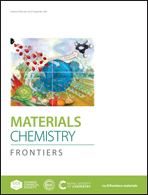High conductivity and alkaline stability of anion exchange membranes containing multiple flexible side-chain piperidinium ions†
Abstract
A class of poly(aryl ether sulfone) anion exchange membranes (PAES-8mPip-x) containing eight flexible piperidinium ions in the repeating unit were prepared using 4,4′-difluorodiphenylsulfone, 2,2′-bis(4-hydroxyphenyl)-hexafluoropropane and 3,3′,5,5′-tetrakis(3′′,5′′-dimethoxyphenyl)-4,4′-difluorodiphenyl sulfone via aromatic nucleophilic polycondensation, demethylation reaction and Williamson reaction. The membranes possessed good flexibility, clear phase separation structures and continuous ion conduction channels. PAES-8mPip-x (1.26–1.90 mmol g−1) exhibited high water absorption, low size swelling and excellent OH− conductivity due to the incorporation of highly distributed flexible side piperidinium ions, and their values were in the range of 44.8–104.4%, 14.4–25.3% and 49.5–114.2 mS cm−1 at 60 °C, respectively. The membranes also had excellent alkaline stability. Their retention value of OH− conductivity reached 88.2% after immersing in a 2 mol L−1 NaOH aqueous solution at 80 °C for 480 h. This study demonstrates that the ionic conductivity and alkaline stability of AEMs can be effectively improved via selecting specific ionic groups and distribution of cations in the structural unit.



 Please wait while we load your content...
Please wait while we load your content...